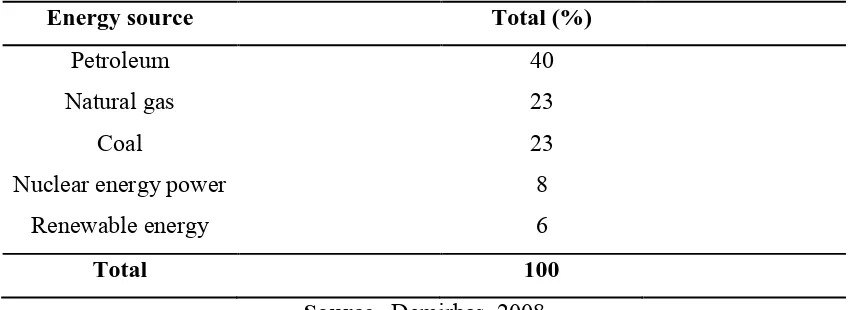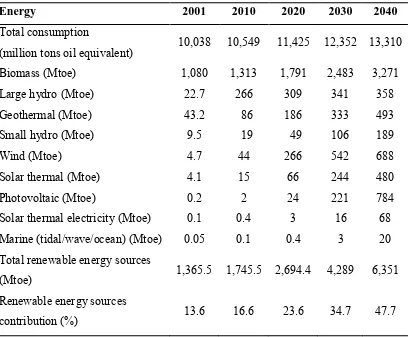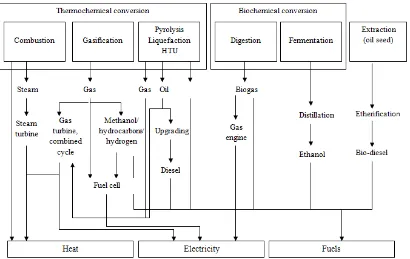DENSIFICATION OF DURIAN PEEL WASTE AS A SOLID BIOFUEL: EFFECT OF BINDER RATIO
MUHAMMAD HAFIZUDDIN BIN MOHD GAZALI
UNIVERSITI TEKNIKAL MALAYSIA MELAKA
M U H A M M A D H A FIZ U D D IN B IN M O H D G A ZA
LI BA
C H EL O R O F M EC H A N IC A L E N G IN EE RIN G (P LA N T & M A IN TE N A N CE ) ( H O N
S.) 2015 U
Te
SUPERVISOR DECLARATION
“I hereby declare that I have read this thesis and in my opinion this thesis is sufficient in terms of scope and quality for the award of the degree of
Bachelor of Mechanical Engineering (Plant & Maintenance)”
DENSIFICATION OF DURIAN PEEL WASTE AS A SOLID BIOFUEL:
EFFECT OF BINDER RATIO
MUHAMMAD HAFIZUDDIN BIN MOHD GAZALI
This thesis is submitted in partial fulfilment of the award of Bachelor of
Mechanical Engineering (Plant & Maintenance) With Honours
Faculty of Mechanical Engineering
Universiti Teknikal Malaysia Melaka
DECLARATION
“I hereby declare that the work in this thesis is my own except for summaries and quotations which have been duly acknowledged.”
Signature :...
iii
DEDICATION
For my beloved
ACKNOWLEDGEMENT
v
ABSTRACT
ABSTRAK
vii
TABLE OF CONTENT
CHAPTER TITLE
PAGE
PROJECT TITLE i
DECLARATION ii
DEDICATION iii
ACKNOWLEDGEMENT iv
ABSTRACT v
ABSTRAK vi
TABLE OF CONTENT vii
LIST OF TABLES xii
LIST OF FIGURES xiii
LIST OF APPENDIX xv
LIST OF ABBREVIATION xvi
CHAPTER 1 INTRODUCTION
1.1 BACKGROUND 1
1.2 PROBLEM STATEMENT 5
1.3 OBJECTIVES 5
1.4 SCOPE 5
CHAPTER 2 LITERATURE REVIEW
2.2 SOLID BIOFUEL 7
2.3 MATERIAL SELECTION 8
2.3.1 Durian 8
2.3.2 Properties of Durian Peel 10
2.4 BINDER MATERIAL 11
2.4.1 Tapioca Starch 12
2.4.2 Calcium Hydroxide 13
2.5 PAST STUDIED 13
2.6 THE ANALYSIS OF BRIQUETTE 17
2.6.1 Proximate Analysis 18 2.6.2.1 Moisture Content 18 2.6.2.2 Ash Content 18 2.6.2.3 Volatile Matter 18 2.6.2.4 Fixed Carbon 19
2.6.2 Calorific Value 19
2.6.3 Mechanical Test 20
2.6.4 FTIR 20
CHAPTER 3 METHODOLOGY
3.1 INTRODUCTION 21
3.2 SAMPLE PREPARATION 23
3.2.1 Collection of Raw Material 23
3.2.2 Drying 23
3.2.3 Crushing 24
ix
3.2.5 Carbonization 24
3.2.6 Mix with Binder 25
3.2.7 Densification 25
3.3 ANALYSIS OF BRIQUETTE PRODUCT 25 3.3.1 Proximate Analysis 26 3.3.2.1 Moisture Content 26 3.3.2.2 Ash Content 26 3.3.2.3 Volatile Matter 27 3.3.2.4 Fixed Carbon 28
3.3.2 Calorific Value 28
3.3.3 Compressive Test 29
3.3.4 FTIR 29
CHAPTER 4 DATA AND RESULT
4.1 INTRODUCTION 30
4.2 BRIQUETTE PREPARATION 31
4.2.1 Drying 31
4.2.2 Crushing 32
4.2.3 Milling 32
4.2.4 Carbonization 33
4.2.5 Binder 33
4.2.6 Densification 34
4.3 BRIQUETTE ANALYSIS 35
4.3.1 Proximate Analysis 36
4.3.1.2 Ash Content 37 4.3.1.3 Volatile Matter 38 4.3.1.4 Fixed Carbon 39
4.3.2 Calorific Value 40
4.3.3 Compressive Test 41
4.3.4 FTIR 42
CHAPTER 5 DISCUSSION AND ANALYSIS
5.1 BRIQUETTE PREPARATION 45
5.1.1 Drying 45
5.1.2 Crushing 45
5.1.3 Milling 46
5.1.4 Carbonization 46
5.1.5 Binder 47
5.1.6 Densification 47
5.2 BRIQUETTE ANALYSIS 47
5.2.1 Proximate Analysis 48
5.2.2 Calorific Value 53
5.2.3 Compressive Test 57
xi
CHAPTER 6 CONCLUSION AND RECOMMENDATION
6.1 CONCLUSION 62
6.2 RECOMMENDATION 63
REFERENCES 64
LIST OF TABLES
NO TITLE PAGE
1.1 Energy consumption around the world at 2005 2
1.2 Estimation of global renewable energy scenario 2040 3 2.1 Result of physicals properties of biomass briquettes 14
2.2 Past studies of durian peel as briquette 16
2.3 Characteristic different briquettes 17
4.1 Moisture and mass of durian peel 31
4.2 Ratio of starch with water 34
4.3 Results of analysis for durian peel briquette 35
xiii
LIST OF FIGURES
NO. TITLE PAGE
1.1 Biomass to energy conversion patterns 4
2.1 Durian fruit 9
2.2 Hardening bonding 12
3.1 Flow chart of durian peel briquette 22
4.1 (a) Oven and (b) dried durian peel 31
4.2 (a) Crusher machine and (b) crushed durian peel 32 4.3 (a) Centrifugal Milling Machine Restch ZM 200 and 32
(b) milled durian peel
4.4 (a) Muffle furnace and (b) carbon of durian peel 33 4.5 (a) Powder of milled durian peel and (b) durian peel carbon 35
4.6 Moisture content of durian peel briquette 36
4.7 Ash content of durian peel briquette 37
4.8 Volatile matter of durian peel briquette 38
4.9 Fixed carbon of durian peel briquette 39
4.10 Calorific value of durian peel briquette 40
4.12 Graph of FTIR analysis of durian peel non-carbon briquette 43 4.13 Graph of FTIR analysis of durian peel carbon briquette 44 5.1 Temperature profile during carbonization process 46
5.2 Comparison between NC and C 48
5.3 Comparison between reference and starch 49
5.4 Comparison between reference and calcium hydroxide 50
5.5 Proximate analysis for all briquettes 51
5.6 Reference of calorific value 53
5.7 Comparison between reference and starch 54
5.8 Comparison of calorific value between reference and 55 calcium hydroxide
5.9 Calorific of all briquettes 56
5.10 Sample graph of compressive test for briquette NC 57
5.11 Example of briquette contain carbon 58
5.12 FTIR of briquette NC and C 59
5.13 FTIR of reference and binder of starch 60
xv
LIST OF APPENDIX
NO. TITLE PAGE
A Moisture Content 68
B Ash Content 69
C Volatile Matter 70
D Fixed Carbon and Calorific value 71
E Results of Compressive Test 72
F Gantt Chart FYP I 77
G Gantt Chart FYP II 78
H ASTM for Moisture Content 79
I ASTM for Ash Content 83
LIST OF ABBREVIATION
ASTM American Standard Testing Method Mtoe Million tons oil equivalent
GHG Green house gas
MC Moisture content
VM Volatile matter
FC Fixed carbon
FTIR Fourier transform infrared spectroscopy
NC Non-carbon
NCS Non-carbon starch
NCC Non-carbon calcium hydroxide
C Carbon
CS Carbon starch
CC Carbon calcium hydroxide
NHV Net heating value/Calorific value
MJ/kg Mega Joule per kilogram
kN Kilo Newton
MPa Mega Pascal
mm Millimeter
Cm Centimeter
m meter
RPM Rotation per minute
G Gram
Kg Kilogram
xvii
Min Minute
cal calori
MT Mega Tons
Mol Molecule
CHAPTER 1
INTRODUCTION
1.1 BACKGROUND
2 For over many years, human’s kind rely on non renewable energy which is fossil fuels such as coal, oil and natural gas for their needs. This can be seen in Table 1.1 where it shows the non renewable energy is the largest source of energy consumed around the world. In fact today, non renewable energy source still being used especially petroleum, coal and natural gas.
Table 1.1: Energy consumption around the world at 2005
Energy source Total (%)
Petroleum 40
Natural gas 23
Coal 23
Nuclear energy power 8
Renewable energy 6
Total 100
Source: Demirbas, 2008
Table 1.2: Estimation of global renewable energy scenario 2040
Energy 2001 2010 2020 2030 2040
Total consumption
(million tons oil equivalent) 10,038 10,549 11,425 12,352 13,310
Biomass (Mtoe) 1,080 1,313 1,791 2,483 3,271
Large hydro (Mtoe) 22.7 266 309 341 358
Geothermal (Mtoe) 43.2 86 186 333 493
Small hydro (Mtoe) 9.5 19 49 106 189
Wind (Mtoe) 4.7 44 266 542 688
Solar thermal (Mtoe) 4.1 15 66 244 480
Photovoltaic (Mtoe) 0.2 2 24 221 784
Solar thermal electricity (Mtoe) 0.1 0.4 3 16 68 Marine (tidal/wave/ocean) (Mtoe) 0.05 0.1 0.4 3 20 Total renewable energy sources
(Mtoe) 1,365.5 1,745.5 2,694.4 4,289 6,351
Renewable energy sources
contribution (%) 13.6 16.6 23.6 34.7 47.7
Source: Demirbas, 2008
4 without affecting environment. Based on David (2008), the derivation of biomass used for transportation purposes is called as biofuel. Besides, the derivation of biomass into biofuels requires several steps, which are thermochemical and biochemical conversion. By doing these conversion, they can supply energy such as heat, electricity and fuels as shown in Figure 1.1. The conversion of biomass to biofuel can be categorized into three types which are solid, liquid and gas. In this project, solid biofuel that came from durian will be highlighted due to the problem created by the fruits of durian.
1.2 PROBLEM STATEMENT
Durian is one of the sources of biomass and durian is a seasonal fruit but lately, it can be obtained at any time even in the off-season of durian because of advance in agricultural technology. There are so many application of durian in food processing industries such as being adopted in several culinary preparations. With the availability of durian fruits in Malaysia, it not impossible this country been hampered by the massive generation of durian residues especially in form of durian peel which almost covering around 60-75 % of the entire fruit (Foo and Hameed, 2012). The presence of abundance of the durian peel residues, it can create major problems to respiratory diseases, besides of their pungent smell (Chandra et al., 2009). In order to solve this problem, a conversion of durian peel residues into briquette as a solid biofuel will be done to avoid any polluted pungent smell (Wahidin, and Anisa, 2014).
1.3 OBJECTIVES
There are several objectives on completing of densification of durian peel waste as a solid biofuel with effect of binder ratio which are:
1. To produce the briquette from durian peel waste.
2. To identify the effect of binder ratio (starch and calcium hydroxide) to the calorific value of briquette.
3. To analyze briquette product (proximate analysis, mechanical properties and functional group of briquette).


